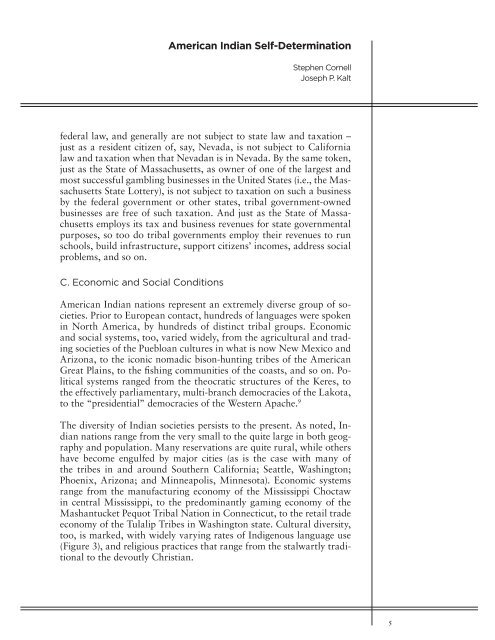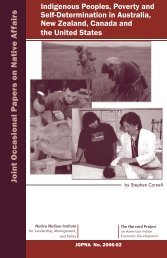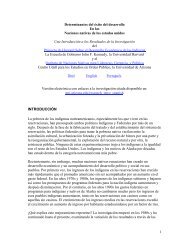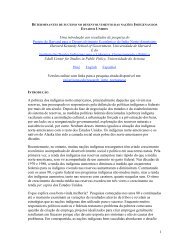American Indian Self-Determination - Native Nations Institute ...
American Indian Self-Determination - Native Nations Institute ...
American Indian Self-Determination - Native Nations Institute ...
- No tags were found...
You also want an ePaper? Increase the reach of your titles
YUMPU automatically turns print PDFs into web optimized ePapers that Google loves.
<strong>American</strong> <strong>Indian</strong> <strong>Self</strong>-<strong>Determination</strong>Stephen CornellJoseph P. Kaltfederal law, and generally are not subject to state law and taxation –just as a resident citizen of, say, Nevada, is not subject to Californialaw and taxation when that Nevadan is in Nevada. By the same token,just as the State of Massachusetts, as owner of one of the largest andmost successful gambling businesses in the United States (i.e., the MassachusettsState Lottery), is not subject to taxation on such a businessby the federal government or other states, tribal government-ownedbusinesses are free of such taxation. And just as the State of Massachusettsemploys its tax and business revenues for state governmentalpurposes, so too do tribal governments employ their revenues to runschools, build infrastructure, support citizens’ incomes, address socialproblems, and so on.C. Economic and Social Conditions<strong>American</strong> <strong>Indian</strong> nations represent an extremely diverse group of societies.Prior to European contact, hundreds of languages were spokenin North America, by hundreds of distinct tribal groups. Economicand social systems, too, varied widely, from the agricultural and tradingsocieties of the Puebloan cultures in what is now New Mexico andArizona, to the iconic nomadic bison-hunting tribes of the <strong>American</strong>Great Plains, to the fishing communities of the coasts, and so on. Politicalsystems ranged from the theocratic structures of the Keres, tothe effectively parliamentary, multi-branch democracies of the Lakota,to the “presidential” democracies of the Western Apache. 9The diversity of <strong>Indian</strong> societies persists to the present. As noted, <strong>Indian</strong>nations range from the very small to the quite large in both geographyand population. Many reservations are quite rural, while othershave become engulfed by major cities (as is the case with many ofthe tribes in and around Southern California; Seattle, Washington;Phoenix, Arizona; and Minneapolis, Minnesota). Economic systemsrange from the manufacturing economy of the Mississippi Choctawin central Mississippi, to the predominantly gaming economy of theMashantucket Pequot Tribal Nation in Connecticut, to the retail tradeeconomy of the Tulalip Tribes in Washington state. Cultural diversity,too, is marked, with widely varying rates of Indigenous language use(Figure 3), and religious practices that range from the stalwartly traditionalto the devoutly Christian.5







